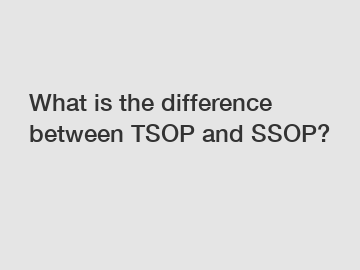What is the difference between TSOP and SSOP?
When it comes to integrated circuits and semiconductor packaging, there are a wide variety of options available. Two popular options are Thin Small Outline Package (TSOP) and Shrink Small Outline Package (SSOP). While both packages serve the same essential purpose, there are some key differences between the two that can impact their use in different applications.
TSOP, or Thin Small Outline Package, is a type of surface-mount packaging that is commonly used for memory devices, such as DRAM and Flash memory. The package is characterized by its thin profile and small outline, making it ideal for applications where space is limited. TSOP packages typically have a gull-wing lead configuration, which allows for easy soldering onto a printed circuit board.
SSOP, or Shrink Small Outline Package, is another type of surface-mount packaging that is similar to TSOP but with some key differences. SSOP packages are typically smaller and have a higher lead count than TSOP packages. This makes them ideal for applications that require a higher pin density, such as microcontrollers and other complex integrated circuits. SSOP packages also have a smaller pitch, which allows for tighter spacing between leads and a smaller overall package size.

One of the main differences between TSOP and SSOP is their size and lead count. TSOP packages are typically larger and have fewer leads than SSOP packages. This makes TSOP packages more suitable for applications where space is not a limiting factor and a lower pin count is sufficient. On the other hand, SSOP packages are ideal for applications where a higher pin density is required, as they can accommodate more leads in a smaller package size.
Another key difference between TSOP and SSOP is their pitch, or the distance between the leads. TSOP packages typically have a larger pitch than SSOP packages, which allows for easier routing of traces on a PCB. However, SSOP packages have a smaller pitch, which allows for tighter spacing between leads and a higher pin density. This can be advantageous in applications where space is limited and a smaller package size is required.
In terms of performance, both TSOP and SSOP packages offer similar electrical characteristics. However, SSOP packages may have better thermal performance due to their smaller size and higher pin density. This can be important in applications where heat dissipation is a concern, such as in high-power circuits or in environments with limited airflow.
Overall, the choice between TSOP and SSOP will depend on the specific requirements of the application. TSOP packages are well-suited for applications where space is not a limiting factor and a lower pin count is sufficient. On the other hand, SSOP packages are ideal for applications that require a higher pin density and where space is at a premium.
In conclusion, TSOP and SSOP are both popular options for semiconductor packaging, each with its own unique characteristics and advantages. Understanding the differences between the two packages can help designers and engineers make informed decisions when selecting the best package for their specific application. Whether it's a memory device or a microcontroller, choosing the right package can have a significant impact on the performance and reliability of the overall system.
For more Discrete Semiconductor Manufacturers, ceramic needle grid array package CPGA, EP4CE6F17C7N Stock & Priceinformation, please contact us. We will provide professional answers.
164
0
0


Comments
All Comments (0)